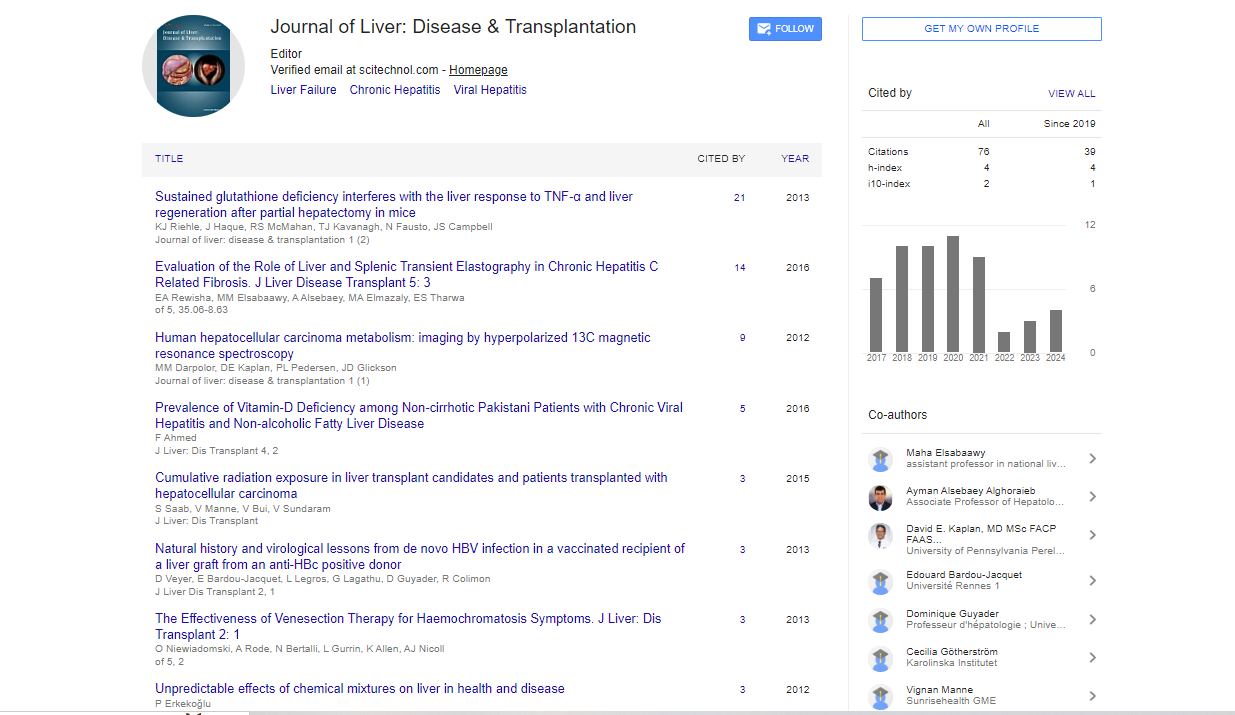Perspective, J Liver Disease Transplant Vol: 12 Issue: 4
Hemochromatosis Insights from Genetics to Treatment
Emi Takashu*
1Department of Gastroenterological and Transplant Surgery, Hiroshima University, Hiroshima, Japan
*Corresponding Author: Emi Takashu,
Department of Gastroenterological and
Transplant Surgery, Hiroshima University, Hiroshima, Japan
E-mail: takashu@hiroshima-u.ac.jp
Received date: 20 November, 2023, Manuscript No. JLDT-23-123845;
Editor assigned date: 22 November, 2023, Pre QC No. JLDT-23-123845 (PQ);
Reviewed date: 06 December, 2023, QC No. JLDT-23-123845;
Revised date: 13 December, 2023, Manuscript No. JLDT-23-123845 (R);
Published date: 20 December, 2023, DOI: 10.36648/2325-9612.100242
Citation: Takashu E (2023) Hemochromatosis Insights from Genetics to Treatment. J Liver Disease Transplant 12:4.
Description
Hemochromatosis, a hereditary disorder characterized by excessive iron absorption and deposition in various organs, poses a complex challenge to both patients and healthcare professionals. As one of the most common genetic disorders, hemochromatosis demands a comprehensive exploration of its underlying mechanisms, clinical manifestations, diagnosis, and management. The most common form of the disorder, known as Hereditary Hemochromatosis (HH), is primarily associated with mutations in the HFE gene. The HFE gene plays a crucial role in regulating iron absorption in the small intestine by interacting with a protein called transferrin receptor. The most prevalent mutations linked to hemochromatosis are C282Y and H63D in the HFE gene. Homozygosity for the C282Y mutation is strongly associated with increased iron absorption, while the H63D mutation is considered a less penetrant contributor to iron overload. Individuals with two copies of the C282Y mutation (C282Y/C282Y) are at the highest risk of developing clinically significant iron overload. While HFE mutations are the primary culprits, other rare forms of hemochromatosis involve mutations in genes such as HAMP, HJV, TFR2, and SLC40A1. These non-HFE forms often present with distinct clinical features and may require specialized diagnostic approaches.
The consequences of hemochromatosis arise from the progressive accumulation of iron in vital organs, leading to a myriad of health issues. The clinical manifestations can vary widely, and the severity of symptoms often depends on factors such as the extent of iron overload and individual susceptibility. Excess iron tends to accumulate in the liver, pancreas, heart, joints, and other tissues. The liver is particularly susceptible to damage, progressing from simple hepatic iron overload to conditions like cirrhosis, hepatocellular carcinoma, and liver failure. Iron deposition in the pancreas can result in diabetes mellitus, while the heart may suffer from cardiomyopathy and arrhythmias. Hemochromatosis frequently manifests as joint pain and arthritis, commonly affecting the metacarpophalangeal and wrist joints. This arthropathy results from iron deposition in the synovium and joint spaces, leading to inflammation and tissue damage. Iron overload can disrupt endocrine function, contributing to hypogonadism, thyroid dysfunction, and adrenal insufficiency. These hormonal imbalances further complicate the clinical picture of hemochromatosis, impacting reproductive health and metabolic homeostasis. The skin may exhibit characteristic changes, including hyperpigmentation, commonly referred to as "bronze diabetes." This discoloration results from the deposition of iron in the skin and is often a late finding in the course of the disease.
Diagnosis and screening
Timely and accurate diagnosis of hemochromatosis is crucial for implementing effective interventions and preventing irreversible organ damage. Various diagnostic tools and screening strategies are employed to identify individuals at risk or those presenting with symptoms suggestive of iron overload. Genetic testing for HFE mutations is a cornerstone in the diagnosis of hereditary hemochromatosis. Identifying individuals with homozygous or compound heterozygous mutations provides valuable information about their risk of developing iron overload. Routine serum iron studies, including serum iron, transferrin saturation, and ferritin levels, are essential components of hemochromatosis screening. Elevated transferrin saturation and ferritin levels, coupled with a high serum iron concentration, are indicative of iron overload. In certain cases, liver biopsy or non-invasive imaging techniques such as Magnetic Resonance Imaging (MRI) may be employed to assess the extent of liver damage and iron deposition. Liver iron concentration measurements are valuable for guiding treatment decisions.
Phlebotomy, the removal of blood, is the primary treatment modality for hemochromatosis. Regular phlebotomy sessions help deplete excess iron stores, promoting a gradual reduction in iron levels. The frequency and duration of phlebotomy are tailored to individual patient needs and iron status. In cases where phlebotomy is contraindicated or insufficient, iron chelation therapy may be considered. Chelating agents, such as deferoxamine, deferasirox, and deferiprone, bind to iron and facilitate its excretion from the body. However, these agents are typically reserved for specific circumstances due to their potential side effects. Addressing complications associated with hemochromatosis involves a multidisciplinary approach. Management of cirrhosis, diabetes, heart failure, and other complications requires specialized care and ongoing monitoring to optimize patient outcomes.
Conclusion
Hemochromatosis, with its intricate genetic basis and diverse clinical manifestations, stands as a significant health challenge. Advances in genetic testing, screening strategies, and treatment modalities have transformed the landscape of hemochromatosis management. Early diagnosis and intervention hold the key to preventing irreversible organ damage and improving the quality of life for individuals affected by this iron overload disorder. As study continues to unveil the complexities of hemochromatosis, ongoing efforts are essential to refine diagnostic approaches, explore novel therapeutic avenues, and enhance our understanding of the genetic and environmental factors influencing the disease. Through collaborative efforts between studyers, clinicians, and affected individuals, the journey toward unraveling the hemochromatosis puzzle continues, offering hope for improved outcomes and a brighter future for those navigating this intricate medical landscape.
 Spanish
Spanish  Chinese
Chinese  Russian
Russian  German
German  French
French  Japanese
Japanese  Portuguese
Portuguese  Hindi
Hindi 